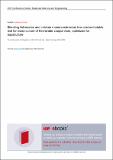| dc.description.abstract | This study investigated the feasibility of fishwastes and chicken manure extract
(CME) as cheap diet for mass culture of freshwater zooplankton. CME and fishwastes as
well as carbon source were used to make fishwaste diets (FWD). Each diet was triplicated 3
days before inoculation with 5, 2 and 0.4 ind ml-1 of rotifers, copepods and cladocerans,
respectively in each tank. About 5ml of water was done daily, from which the zooplankters
were counted. Harvesting was done at the first exponential growth phase by replacing 50%
of the water and FWD. There was a significantly higher density of zooplankton and SGR in
FWDB than FWDA and control tanks. The zooplankton obtained highest densities on day 7
as follows: rotifers: 100.6±14.8, 146.3±7.0, and 60.0±7.9 ind ml-1 in FWDA, FWDB and the
control tanks, respectively; the copepods: 8.0±11.1, 12.6±13.6 and 4.3±2.1 ind ml-1 in
FWDA, FWDB and control tanks, respectively; the cladocerans: 3.3 ± 6.0, 8.6 ± 8.7 and
3.6±2.5 ind ml-1 in FWDA, FWDB and control tanks, respectively. The most abundant
genera were Brachionus sp., Cyclops sp. and Daphnia sp. for the rotifers, copepods and
cladocerans, respectively. This study offers an alternative to expensive on-site microalgal
production toward a more cost-effective aquaculture. | en_US |

